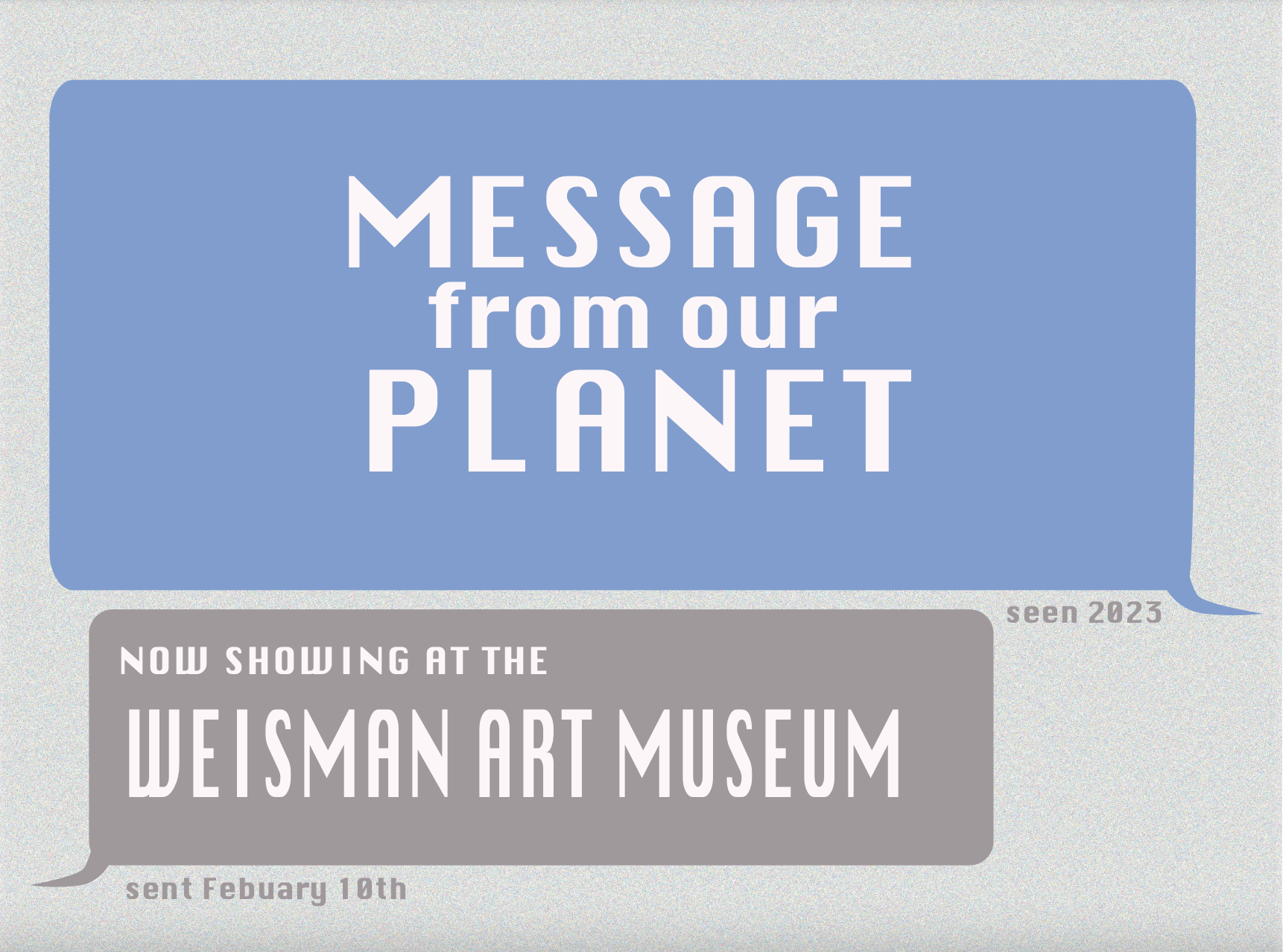Message From Our Planet: Weisman’s New Exhibit
I love the Weisman art museum. I love it during the day, when the shapely skylights filter sunlight onto their collection of pieces, carving out every detail; and I love it during the night, when dim gallery lights warm the outside chill out of you, inviting conversation and inspiring thought. It was on one of these nights that the opening for the Weisman’s new exhibit, Message From Our Planet, fell. White gallery walls aside, there was nothing plain about the collection. The pieces provoked much contemplation—tangibly about the pieces, intangibly about something bigger than the exhibit itself.
Message From Our Planet features artworks from 19 international artists working in creative mediums. The collection “proposes that media technologies–from vintage devices to cutting-edge digital algorithms–offer distinct ways for artists to communicate with future generations, encapsulating the artifacts and ambitions of contemporary society,” (per their exhibition website). The exhibit challenges how a message can be conveyed through a piece of art, pushing the boundaries on what a dialogue can look like. One of the headlining pieces in the exhibition, a projected video with sound accessible through wired headphones, presented a phone call from the “Western World”. Entitled Sorry For Real and created by digital video artist Tabita Rezaire, the video follows a conversation on a digitally modeled cell phone taking place in a liminal digital galaxy, wherein the “Western World” on the other end of the line apologizes in monotone for colonialism, genocide, crimes against Afro-descendants, and patriarchy, among other horrors. This piece, a take on the politics of reparations, questions the breach between intention and action. It begs: can the Western World truly apologize?
Opposite the main entrance hung one of my personal favorite pieces of the collection, entitled 48,586,054 Suns from Sunsets from Flickr (Partial). The large wall installation consists of 1,440 standard-photo-size pictures–each a unique sunset image, taken by unknown photographers, that the artist Penelope Umbirco found on photo-sharing site Flickr. On the piece, Umbrico explained her fascination with this “collective practice” of photographing sunsets because it is “something we all engage in despite any artistic concern, knowing that there have been millions before and there will be millions after.” In an interview with aPhotoEditor, Umbrico further divulged that she was “using images that speak to the [individuality] of those photographers, but erasing the subjectivity I find in the image to point to the subjects’ inadvertent, unintended, participation in a collective process.” She also explained how she interprets the motive of this action: “I got the picture. I got the sun. It’s a way of owning an object that you actually can’t own – the photo trophy thing.”
This collection explored to great lengths the ways in which the planet could convey a message. Alongside paper images and projected videography, the exhibit presents LED signage (Red Tilt by Jenny Holzer), 3D printed ceramics (Braided Woman by Matthew Angelo Harrison), and a collage of computer motherboards arranged in a humanoid light-and-shadow silhouette (While Observing by Elias Sime). The piece that sparked the most discussion among those I attended the show with was being shown on a small box television in the center room. The TV blazed with a reel of a boxer in a ring on loop. On first glance, the boxer was seemingly wracked with full-body tremors. After watching it a few times (and consulting the plaque on the wall), we discovered that it was not, in fact, tremors, moving his body–the motion was caused by impact from an invisible rival boxer was hitting him. The opponent in the match had been fully erased from the film through meticulous digital editing. The artist, Paul Pfeiffer, created this piece (entitled Caryatid (Stiverne)) as a critique on the glamorization of violence, particularly against black bodies, in spectator sports.
Regardless of how certain one is upon arrival with their idea in mind of what’s to come (after all, the title, “Message From Our Planet”, leaves seemingly little room for interpretation), one leaves this collection with a longer list of questions about the exhibit than they came with. As I put my coat back on at the end of the event and prepared to be swept back out into that cold night, I pondered some of the new questions on my list–such as, to use the words of the opening night brochure, “How will our signals be received by new generations?” And, more despairingly, “Will they even want to hear from us?”









